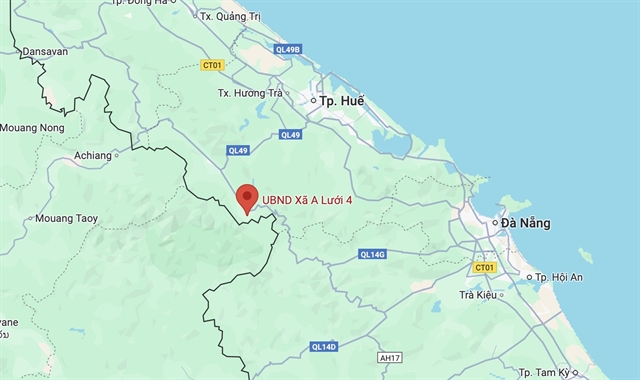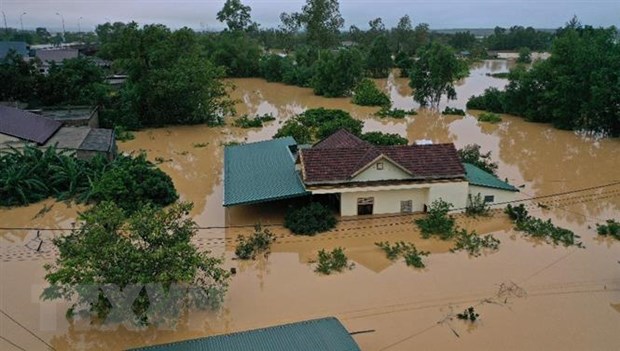 Environment
Environment

A report titled “Climate change in Viet Nam, Impacts and Adaptation” has been introduced within the framework of COP26 in Glasgow, UK.

|
| Serious flooding hit the central province of Quảng Trị in October 2020. VNA/VNS Photo Hồ Cầu |
A report titled “Climate change in Viet Nam, Impacts and Adaptation” has been introduced within the framework of COP26 in Glasgow, UK.
The report, developed by more than 60 Vietnamese and French researchers, covers their common willingness to develop a long-term vision of the economic, social and territorial issues of resilient development for Việt Nam.
Two of the researchers, Etienne Espagne, Senior Economist of the French Development Agency, and Associate Professor Dr Ngô Đức Thành from the University of Science and Technology of Hà Nội – spoke to local media about the report.
Can you briefly introduce the report and its aims?
Espagne: The report is the result of a large-scale project by the French Development Agency (AFD), General Monetary and Multisectoral Macrodynamics for the Ecological Shift (GEMMES), with the overall objective of assessing the macroeconomic impacts of climate change and simulating potential adaptation strategies in various developing countries. Adapted in six countries - Brazil, Colombia, Côte d'Ivoire, Morocco, Tunisia and Việt Nam, the project dedicated to Viet Nam (Gemmes-VN) which kicked off in 2019, focuses on the capacity of coastal zones to adapt to the unavoidable impacts of climate change and to increase their contribution to mitigation, thus strengthening global resilience.
The use of the 2050 Facility to finance this applied research project is fully justified by its long-term prospective approach, a focus on issues of adaptation and resilience and strong expectations on the Vietnamese side.
Việt Nam is often presented as one of the countries that are most vulnerable to climate change. The Ministry of Natural Resources and Environment, AFD and the French National Research Institute for Sustainable Development (IRD) have undertaken the ambitious scientific collaboration around the GEMMES Việt Nam project with the general objective to support the country in the implementation of the Paris Climate Agreement regarding impacts and adaptation.
On the occasion of COP26, this report is proposing an assessment of the socio-economic impacts of climate change in Việt Nam by 2050 and scenarios for the country when global average temperature increases by 1.5-2 degrees Celsius, particularly those relating to health, energy, agriculture and household incomes. The report also includes climate change impacts on Việt Nam’s macroeconomy and the Mekong Delta region.
Regarding economic impacts, according to scenarios, when global temperature increases by 1.5 degrees Celsius in mid-2025, Việt Nam will lose 4.5 per cent of GDP yearly. When the global temperature increases by 2 degrees Celsius around 2040, the losses account for 6.7 per cent of GDP yearly.
In addition to direct visible impacts of climate change, there are indirect/invisible impacts that could result in the reduction of up to 30 per cent of the country’s GDP.
The report also mentions the complexity of impacts caused by climate change and environmental changes caused by other reasons, particularly due to human activities.
About ten days ago, the report was handed over to MONRE. We expect that it would be helpful material for scientists and policymakers when developing and making important climate change policies.
What is the visible evidence of climate change and its impacts in Việt Nam?
Thành: To assess the impacts of climate change on different sectors, it is necessary to have climate information in the past, at present and in the future. The report built a database on Việt Nam's climate for the last 40 years.
Data shows that average temperatures and rainfall in Việt Nam increased over recent years, causing extreme weather such as days with high temperatures, the number of heatwaves in a year, floods or droughts.
Over the 1981-2018 period, annual temperatures increased by a nationwide average of 0.21 degrees Celsius per decade while the annual rainfall increased slightly by 5.5 per cent for the country as a whole with contrasting trends depending on the region.
The trend for the sea-level rise was about 3.6mm per year during the 1993-2018 period.
Such data partly reflects that climate change did happen and is happening now in Việt Nam.
For future projections, two downscale approaches – dynamical and statistical – are applied. The statistical one is used to downscale 31 global models under four Representative Concentration Pathways (RCPs) scenarios while experiments are used to dynamically project temperature/rainfall.
According to the results, average temperature in Việt Nam in the middle or at the end of the 21st century is projected to increase by 1.13 ±0.87 degrees Celsius under RCP 2.6 and 1.9± 0.81 degrees Celsius under RCP 8.5 relative to the baseline 1986-2005 period.
Annual rainfall obtained with the dynamic approach is projected to increase in most parts of Việt Nam in the future but with a different seasonal distribution. Sea level rise in the coastal areas is projected to increase by between 0.24 and 0.27m in the mid-century period; between 0.44m and 0.73m at the end of the century.
What sectors do you think make climate change in Việt Nam more serious? What sectors are most affected by climate change’s impacts?
Espagne: In my opinion, energy, particularly the use of fossil energy and transportation contribute most to worsening climate change. Meanwhile, climate change and its negative impacts such as rising sea levels and more natural disasters heavily affected the agriculture and infrastructure sector.
Infrastructure works are more vulnerable to being damaged by natural disasters like floods, storms or earthquakes.
Responding to the impacts, changes need to be made. We must shift to greener energies instead of fossil energy, improve energy efficiency and use electrical transportation.
Once designing or developing infrastructure works, priority should be given to models that can adapt to harsher weather conditions.
To mitigate the negative impacts of climate change, it is proposed that the world reduce 7-8 per cent of the emissions of greenhouse gases for ten continuous years. The rate is similar to the reduction that the world forcibly obtained last year during the COVID-19 pandemic when many human activities and interventions were disrupted.
However, we need to reduce the emissions with voluntary measures instead of being placed in a force majeure situation like the pandemic.
Does the report have specific recommendations for each sector affected by climate change? Can you name some major recommendations for agriculture and the Mekong Delta region which are said to be most vulnerable to climate change in Việt Nam?
Each chapter in the report deals with a key issue or sector that is affected by climate change in Việt Nam. To compile a chapter, we closely co-operated with relevant agencies, research institutes and experts to analyse the situation in Việt Nam and then, offer recommendations.
For countries with emerging economies like Việt Nam, the adaptation to climate change must not involve a single specific sector but the whole country, the whole economy. Thus, comprehensive inclusive policies are needed to ensure a proper adaptation.
The Vietnamese Mekong Delta is for example subject to a combination of drivers of change, of which, anthropogenic drivers – namely hydropower dams, sand mining and groundwater extractions – pose the greatest threats in the first half of this century while climate change will probably dominate the second half of the century.
The Mekong Delta region has an extremely low-lying delta plain with an average elevation of about 80cm. Therefore, it’s extremely vulnerable to even small changes in relative sea level, which arise from the cumulative effects of global sea-level change and local vertical land movements, for example, land subsidence. So, it is important to limit activities like sand mining or underground water extractions. The Government of Việt Nam was aware of the issue and had policies to solve it.
The Mekong Delta region is also strongly influenced by the water governance of the whole Mekong Basin. A regional mechanism to manage dams and reservoirs upstream of the Mekong River is very important to ensure water supply for downstream areas.
Other key recommendations in the report are to strengthen data gathering and availability, to encourage local resilience and to mainstream adaptation into development planning.
Weather forecast and early warning systems and raising awareness on adaptation are still needed to improve preventive and proactive actions. The availability of good statistical data is also crucial to understanding the role of climate finance.
Regarding local resilience, the ability of local actors to mobilise various sources to restore and implement everyday pragmatic adjustments and to develop multiple options to cope with shocks, reveals a high degree of flexibility at the local level that can foster adaptive capacity and reinforce resilience.
What are your recommendations for better observing climate change in Việt Nam?
Thành: When assessing climate change, the most important work is to develop a database. However, one of the biggest problems that researchers face is the uncertainty of results and scenarios. Thus, it is very important to choose results/scenarios. Moreover, uncertainty must be taken into account in all decision-making processes.
Once the climate database is developed, it should be used and shared widely. The more people use that database, the more meaningful the data is.
For example, the uncertainty in rainfall projection over Việt Nam is an issue that needs further careful study in future, particularly when updating the scenarios with the recent available outputs of CMIP 6 - Coupled Model Intercomparison Project of World Climate Research Programme.
The downscale results from CMIP 5 Global Climate Models might not cover all probabilities that may occur in the future. A study that applies the probabilities method could be envisaged to build a new high-resolution climate change scenario set for Việt Nam. This new approach is expected to better depict the tails of the probability distribution and thus could better take into account the extreme risks that might occur in future. VNS